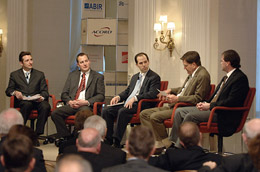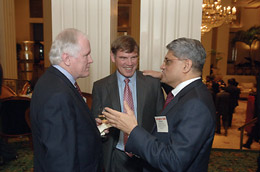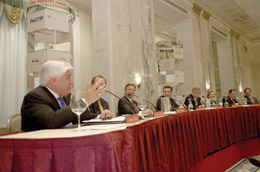|
Looking to the future
Panel assesses industry performance to improve future responses
By Phil Zinkewicz
A property and casualty insurance industry dealing from a position of financial strength plus new challenges facing that very industry were among topics under discussion at the 11th annual Property/Casualty Insurance Joint Industry Forum, sponsored in January by the Insurance Information Institute (I.I.I.). Held in New York, the forum consisted of two panels—the first consisting of industry observers commenting on the industry and the second made up of industry representatives.
The unspoken theme of this year’s forum could have been characterized as “We’re All Right Jack, But Where Do We Go From Here,” with some speakers cheering industry performance over the last three years and others warning that softening of certain lines could damage the industry in years to come.
The first panel, titled “View From the Outside Looking In,” consisted of Dr. Robert P. Hartwig, president and chief economist for the I.I.I., who moderated the discussion; Matthew Mosher, group vice president of Global P/C Ratings, A.M. Best Company; Jay Gelb, senior vice president and senior non-life insurance equity analyst, Lehman Brothers; George Dale, Commissioner, Mississippi Department of Insurance; and Brian Sullivan, editor, Risk Information, Inc.
At the start, Dr. Hartwig asked Dale to comment on current litigation in his state regarding the damage caused by Hurricane Katrina. In Mississippi, courts are sitting in judgment over whether certain damages were caused by wind or flood.
Dale said that, as of the time of this forum, no settlements had been reached. “My concern is to make sure that the consumer is protected,” he said. “I don’t want to see a situation where settlements result in insureds getting coupons and the lawyers running off with all the money.” But Dale added that settlements over litigation are only part of the problem. “Settlements over Katrina are important, naturally, but what is even more important is that the industry and regulators come to grips with the issues involved. The industry and the courts have to determine whether wind-driven water is covered under the standard homeowners policy or whether it isn’t.”
Sullivan agreed with Dale. “What needs to be done is to settle the fights about the past but make the issues clear in the future. We need to know if wind-driven water is a covered event, whether it is a flood or whether it is wind. The definition of that is what needs to come out of this or else there is no future certainty.”
Dale said that, immediately after Katrina hit and then subsided, he made a statement to the press to the effect that, in a certain number of cases, flood damage would not be covered under homeowners insurance. “I was inundated with letters from people who claimed I was in the pocket of the insurance industry. So feelings are running high. The same thing happened after Hurricane Camille in 1969, and the issues have not been resolved yet.”
Another subject addressed by the panel is the current positive financial situation that the property and casualty industry is enjoying. Dr. Hartwig said 2006 was a record year for the industry, with net income after taxes at nearly $60 billion, according to the latest estimates. The industry also delivered its best return on equity in about 20 years—in the range of 14%.
“What is driving that is the industry’s very strong underwriting performance,” said Dr. Hartwig. “We are looking at potentially the best combined ratio in 60 years, maybe in the low 90s.” Dr. Hartwig said this was due partly to the huge drop in insured catastrophe losses, which went from $62 billion in 2005 to just $8 billion in 2006. From the investment standpoint, Gelb said he expected industry earnings to remain at robust levels in 2007 and 2008, though perhaps lower than 2006 levels. “Overall the industry’s returns probably peaked in 2006, and part of that is because we had very low catastrophe losses last year. However, the strength of the industry’s balance sheet would allow it to sustain these results going forward.”
Will the industry’s favorable results lead to excessive competition as in years past? Sullivan said that the industry doesn’t appear to be running down “the slippery slope” of price cuts right now. “We have seen more pricing discipline, particularly in personal lines, in the last five years,” he said. “I think it is because no one knows what to do. Everyone wants to grow profitably, but the question is how. I don’t think anybody has been in a situation where we are not cutting prices to grow market share. This would change only if someone were to do something stupid, or there is an unexpected claims shock.”
At the second panel on the forum’s agenda, “View from the Inside Looking Out,” insurance executives took a more detailed look at market conditions.
The panel consisted of Marc Racicot, president, American Insurance Association, who served as moderator; Martin J. Sullivan, president and CEO, American International Group; Jeffrey A. Ludrof, president and CEO of Erie Insurance Group; Brian M. Storms, chairman and CEO, Marsh, Inc.; William J. Mullaney, president, MetLife Auto & Home; Paula Rosput Reynolds, president and CEO, Safeco Corporation; Pierre L. Ozendo, CEO-Americas Division, Swiss Re; and James J. Schiro, CEO, Zurich Financial Services.
Panelists agreed that policyholders nationwide will continue to benefit from the favorable trends in the auto insurance business. They noted that lower frequency of auto accidents, coupled with a reduced severity of injuries suffered in those events because of safer automobiles, have combined to drop industry-wide loss ratios.
“You are going to see selective price cutting in places where companies want to grow, and are going to see some downward pressure on average earned premium,” said Mullaney.
Reynolds agreed that not only were decreased frequency and severity the keys to auto rate reductions, but so, too, were technological advances in measuring and assessing risk.
Panelists also agreed that the workers compensation and directors and officers liability lines are doing well. They warned, however, that new capital coming into the insurance business from the investment community could cause competition to heat up, resulting in a softening market overall.
This panel also referred to the profits of 2006, but with some cautionary notes. AIG’s Sullivan said: “The industry’s balance sheet is in pretty good shape at the present moment,” adding, however, “Many people have heard me say recently that the wind hasn’t stopped blowing, and the earth hasn’t stopped changing, and earthquakes are not seasonal.”
Ozendo said that the quiet 2006 hurricane season did not prompt him to reassess predictions of more frequent and severe storms in the future. “Heightened hurricane activity comes in cycles, which are recorded in decades, not years,” he said, pointing to Hurricane Katrina’s industry-wide insured losses of $65 billion in 2005.
Schiro added: “Before we pat ourselves on the back over these returns, think about the returns over the last 20 years. The P-C industry, for example, had one of its worst financial years in 2001, and rating agencies are increasingly assessing insurers’ overall strength on their ability to pay claimants in the event of a major catastrophe.”
Storms said: “Clients are enjoying a preferable rate environment right now, but while rate is a factor, that’s not really the issue. Clients are more interested in the financial strength of the companies we’re representing. They’re interested in both the claims-paying ability and willingness and speed at which insurers pay those claims.”
Panelists agreed, however, that the favorable rate climate that insureds are enjoying today does not apply to Florida and states along the Gulf Coast. The reluctance of many P-C insurers to write new Gulf Coast property insurance business or renew existing homeowners or commercial policies has heightened competition in noncoastal parts of the United States, they said.
Finally, as it does every year at the forum, the I.I.I. conducted a survey of the 250 attendees. With a 40% response, the survey showed that leaders of the property/casualty industry today expect Congress to extend the Terrorism Risk and Insurance Act in 2007. Eighty-nine percent of executives are confident that the new Congress will move quickly to extend the law for a significant period or provide a permanent backstop.
When it comes to whether or not Congress will adopt a national catastrophe insurance plan in 2007, however, 88% of respondents do not think it will occur. In addition, 63% of those queried think the push for an optional federal charter will not gain momentum in the new Congress.
Respondents still believe that insurers will prevail in wind vs. water lawsuits. Eighty-one percent are convinced that litigation will be successfully resolved in favor of the insurance industry. * |
|
Click on image for enlargement |
 |
| |
One of the panel discussions at the Property/Casualty Insurance Joint Industry Forum included (from left to right): Dr. Robert P. Hartwig, Insurance Information Institute, (moderator); Matthew Mosher, A.M. Best; Jay Gelb, Lehman Brothers; George Dale, Mississippi Department of Insurance; and Brian Sullivan, Risk Information, Inc. |
| |
 |
| |
Top company execs (from left) Edward M. Liddy, Allstate Insurance Company; Edmund (Ted) F. Kelly, Liberty Mutual; and Ramani Ayer, The Hartford, talk over issues at the Forum. |
| |
 |
| |
Panelists offered insights into the way insurance company CEOs are viewing the P/C industry’s 2006 underwriting profit. At left, Martin J. Sullivan, American International Group, Inc. addresses the audience. |
|


